Jasminum grandiflorum L. - Oleaceae - Catalonian jasmine, Spanish jasmine, Royal jasmine, Chinesischer Tee-Jasmin
Twining deciduous shrub , up to 4m high, native from Northeast Africa to India, occasionally naturalized in tropics, cultivated widely as ornamental.
Subspecies:
Jasminum grandiflorum subsp. floribundum = Jasminum floribundum R. Br. ex Fresen.: native to Africa, Arabia
Jasminum grandiflorum subsp. grandiflorum: South Asia, cultivars and naturalized populations
http://en.wikipedia.org/wiki/Jasminum_grandiflorum
„By method of solvent extraction the Jasmine flowers are converted into Jasmine Concrete and Jasmine Oleoresin (sold as Jasmine Absolute). Both products have a huge demand in the fragrance industry.“ https://en.wikipedia.org/wiki/Jasminum_grandiflorum
Extraction of Turkish jasmine flowers with n-hexane and evaporating of the solvent yielded jasmine concrete (0.20-0.28%). Treating with twenty-fold the weight of alcohol and evaporation of the solvent gave jasmine absolute (39-56%). French, Italian, Indian, Moroccan, Egyptian and Turkish absolutes contained alcohol (2.9-36.3%), linalool (2.5-4.3%), benzyl acetate (9.0-18.8%), benzyl alcohol (0.6-2.0%), nerol/geraniol (0-0.5%), nerolidol (0-1.4%), p-cresol (0.08-1.3%), eugenol (0.1-1.5%), methyl anthranilate/methyl palmitate (0.8-1.7%), jasmonates (0.3-1.0%), isophytol/farnesol (7.5-13.9%), indole (0.4-4.0%), methyl linoleate/vanillin (0.5-2.3%), and benzyl benzoate (1.0-3.5%).
[Anac, Olcay. „Gas chromatographic analysis of absolutes and volatile oil isolated from Turkish and foreign jasmine concretes.“ Flavour and fragrance journal 1.3 (1986): 115-119]
The comparative headspace analysis of J.grandiflorum flowers showed a very interesting variation of constituents. One can easily see the drastic difference between the living and picked flowers (living/picked): 6-methyl-5-hepten-2-one (0.2/0%), (Z)-3-hexenyl acetate (0.2/0%), (Z,E)-ocimene (0.2/1.1%), benzyl alcohol (0/4%), benzyl acetate (60/40%), linalool (3/30%), indole (11/2%), cis-jasmone (3/0%), 3,5-dimethyl 2-ethylpyrazine (0/0.5%), methyl jasmonate (0.3/0%).
[Mookherjee BD et al., „Fruits and Flowers: Live vs Dead - Which do we want?“, in: Nishimura, O. „Flavors and Fragrances, a world perspective.“ Proceedings of the 10th international congress of essential oils, fragrances and flavors, Washington, DC. Vol. 375. 1986, 415-424]
[The chemistry of flowers, fruits and spices: live vs. dead-a new dimension in fragrance research., Mookherjee, B.D., Trenkle, R.W., Wilson, R.A., Pure and Applied Chemistry, Vol.62(7), 1990, 1357-1364] http://media.iupac.org/publications/pac/1990/pdf/6207x1357.pdf
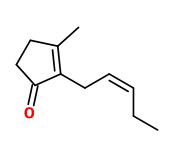 cis-jasmone | 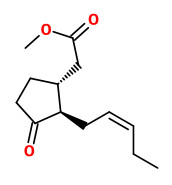 methyl trans-(Z)-jasmonate ((-)-methyl jasmonate) | 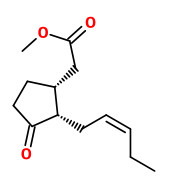 (+)-epi-methyl jasmonate | 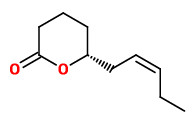 (-)-δ-jasmolactone |
The headspace of J.grandiflorum cultivated in Grasse contained maltol, which contributes an attractive and characteristic 'jammy' note to the flower scent.
[Joulain, Daniel. „Flower scents from the Pacific.“ Chemistry & biodiversity 5.6 (2008): 896-909]
The only constituents >1.5% in the vacuum headspace sample of J.officinale subsp.grandiflorum were benzyl acetate (52.2%), benzyl alcohol (3.2%), and linalool (17.3%). Interesting minor constituents were e.g. p-cresol (0.7%), methyl benzoate (0.7%), methyl salicylate (0.4%), indole (1.2), and (Z)-jasmone (0.5%).
[Braun, Norbert A., et al. „Jasminum flexile Flower Absolute from India–a Detailed Comparison with Three Other Jasmine Absolutes.“ Natural product communications 4.9 (2009): 1934578×0900400917.]
J.grandiflorum flowers yield 0.2% concrete and from that, 0.1% absolute (8 million flowers = 1000kg give 2.3kg concrete and 1kg absolute). Main components are benzyl acetate (34%), benzyl benzoate (24%), benzyl alcohol (5%), linalool (8%), cis-jasmone (3%), and 1H-indole (2.5%), which together total more than 75% (as shown by works from Albert Hesse and Friedrich Müller 1899-1904). Additional 94 trace compounds that contribute to the typical odor of jasmine absolute have been identified, like p-cresol, geraniol, (E,E)-farnesol, (+)-(R,E)-nerolidol, α-terpineol, and vanillin. The methyl jasmonates (-)-methyl jasmonate (1.7%) and (+)-epi-methyl jasmonate (0.2%; 400 times more potent then the former) comprise the odorous principle of jasmine. δ-Jasmolactone (6-[(Z)-pent-2-enyl]oxan-2-one, 1.5%) contributes with pleasant sweet floral fruity notes to the character of jasmine absolute.
[Scent and Chemistry, Günther Ohloff, Wilhelm Pickenhagen, Philip Kraft, Wiley-VCH, 2012, 259-266]
Benzene extracts of Egyptian jasmine flowers and supercritical fluid extracts of ethanolic infusions
of French Jasminum grandiflorum flowers showed maltol also to be a key odorant. Conventional hexane extraction produces absolutes which contain comparatively much lower amounts of maltol (which is significantly soluble in benzene and ethanol, but only poorly solubilized in hexane). Maltol could also be detected in the headspace of living jasmine flowers, contributing to the exquisite fragrance of natural jasmine.
[Nicolas Baldovini, Jean-Jacques Filippi, „Natural Fragrant Raw Materials“ in: Buettner, Andrea, ed. Springer Handbook of Odor. Springer, 2017, 45; lit. cit.]
Using a total of 14 commercial samples of J. grandiflorum flower absolutes from India, Egypt and Morocco, a composition range of the absolutes was established for the 3 main J. grandiflorum flower grower countries. The 12 main ingredients in the absolutes showed great variations: Linalool (2.0-6.9%), benzyl acetate (15.7-27.6%), indole (0.3-4.9%), (Z)-jasmone (1.2-5.7%), benzyl benzoate (8.8-25.5%), isophytol (4.7-8.2%), geranyllinalool (1.2-3.8%), methyl linoleate (1.7-4.8%), (E)-phytol (4.8-16.8%), (E)-phytyl acetate (2.9-6.8%), squalene (1.7-4.9%), 2,3-epoxy squalene (0.7-11.0%).
[Braun, Norbert A., and Sherina Sim. „Jasminum grandiflorum: influence of flower processing and geographic origin on flower absolute composition.“ Natural Product Communications 15.10 (2020): 1934578×20960998.]
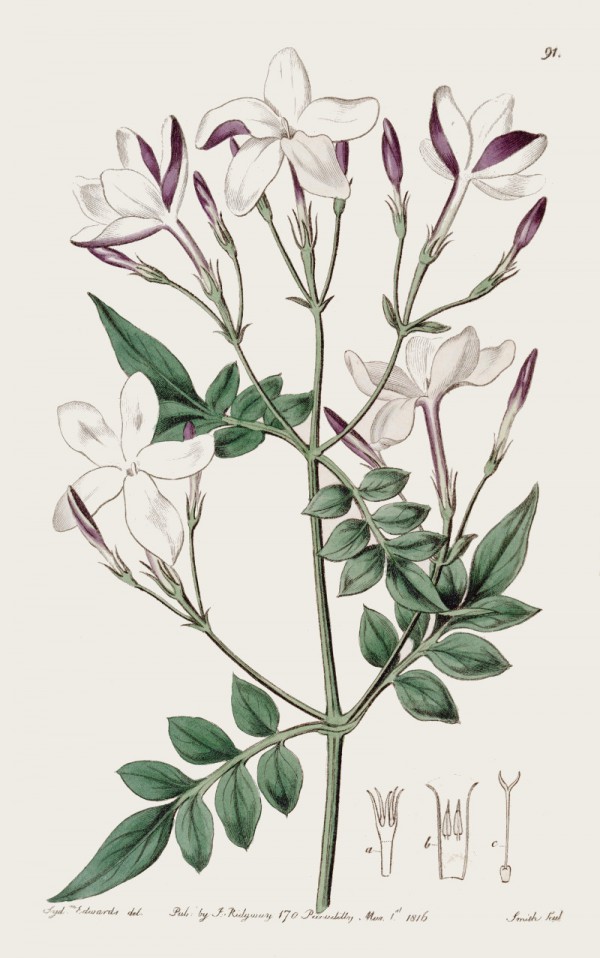
Jasminum grandiflorum L., Malati, Botanical Register, vol. 2: t. 91 (1816) [S. Edwards]
http://www.plantillustrations.org/illustration.php?id_illustration=96958
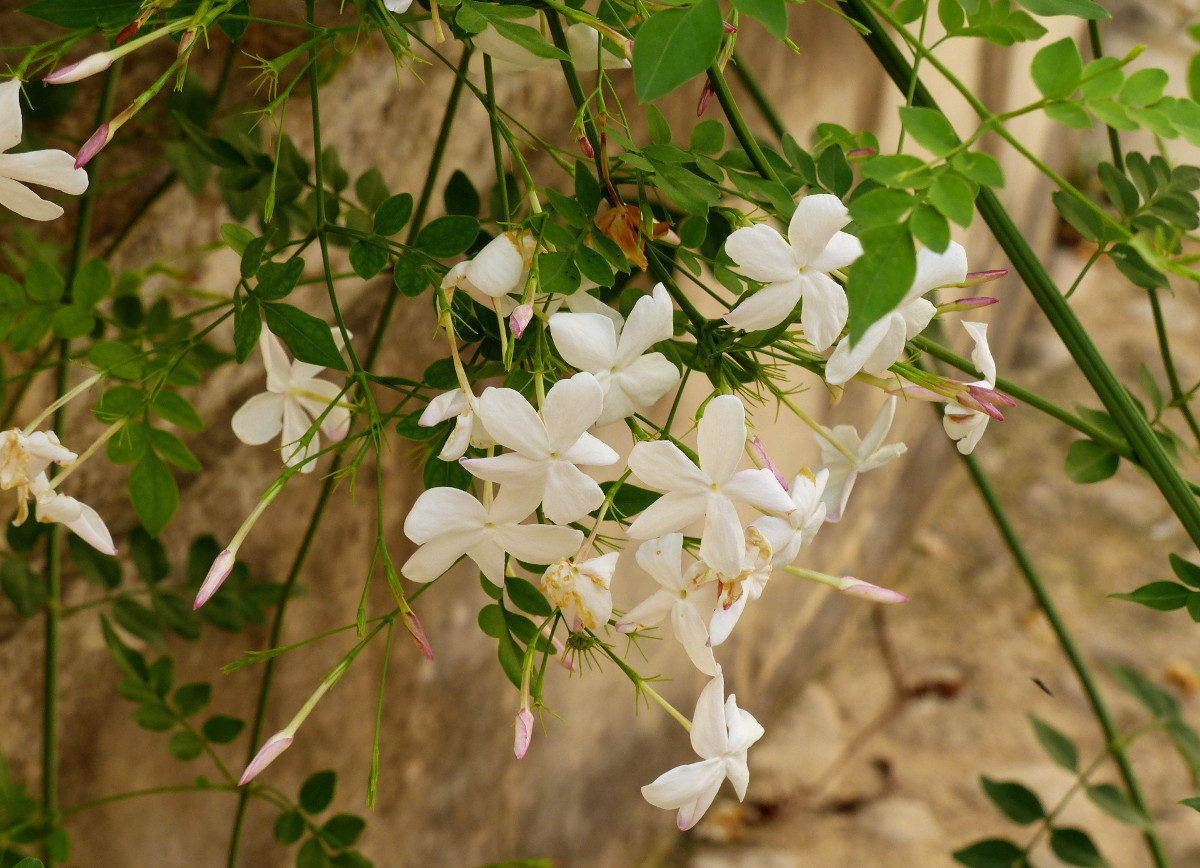
Jasminum grandiflorum L. © Dipartimento di Scienze della Vita, Università di Trieste
Comune di Noto, cortile di Palazzo Landolina, SR, Sicilia, Italia, 06/07/2018
picture by Andrea Moro CC BY-SA 4.0, http://dbiodbs.units.it/carso/chiavi_pub26?spez=5582
VIDEO: Jasminum grandiflorum from Egypt (IFF-LMR)
